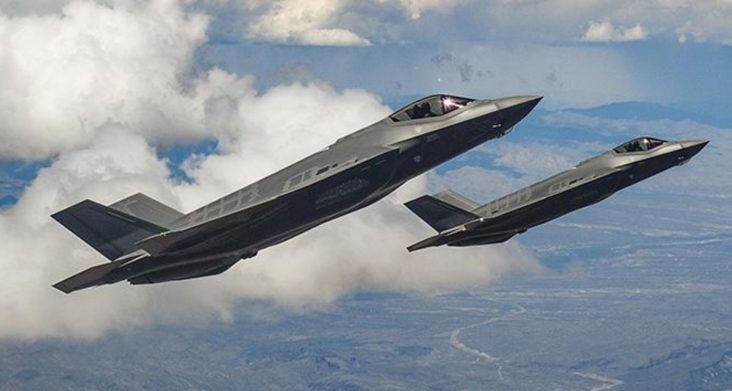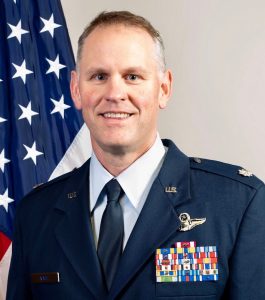Fighter pilots from Poland planned to be the first at training center in Fort Smith
by March 15, 2023 1:46 pm 4,139 views

The F-35
While Singapore pilots have been most associated with the foreign pilot training center to be based in Fort Smith, it will be F-35 pilots from Poland who are expected to first roar into the city’s airspace. But don’t expect to soon hear those fighter planes arrive.
The U.S. Air Force (USAF) on Wednesday (March 15) announced its final decision to place its foreign pilot training center at Ebbing Air National Guard Base in Fort Smith. The center, part of the U.S. Foreign Military Sales (FMS) program, will provide a consolidated location to train foreign pilots from nations that buy U.S.-made military planes.
“Today’s Record of Decision makes official what Arkansans have known since the start of this process – Fort Smith is the premier location for F-35 FMS training and Singapore’s F-16 mission,” U.S. Rep. Steve Womack, R-Rogers, said in a statement. “Fort Smith’s central location, existing infrastructure, and airspace were essential differentiators, but the people of Fort Smith and their desire to support national defense were truly the deciding factors. I’m proud the Air Force has made this final decision and look forward to hearing the ‘Sound of Freedom’ soon in the River Valley.”
‘THE GREEN LIGHT’
Lt. Col. Drew “Gus” Nash has been selected to “execute basing action processes” required to get the new pilot training center operational. Nash, who flew F-16s and A-10s with the 188th when it had a manned mission, is now attached to the 33rd Fighter Wing out of Eglin Air Force Base, which is located northeast of Fort Walton Beach, Fla.
The 188th at Ebbing is the host unit, and Eglin is the tenant which will operate the training center. Nash is the commander of the program integration office, and his boss is Col. Jack “Winder” Arthaud, the 33rd Fighter Wing commander. Col. Jeremiah “Cujo” Gentry is the 188th Wing commander.

Nash, who has 22 years of Air Force service, said the work now begins on facility renovations for personnel and aircraft, aircraft ramp space, personnel decisions to staff the new center, and other key steps required to stand up a training center.
“Now that the record of decision has been signed, now we have the green light to begin executing projects toward making the base ready for this operation. This takes time, which is why we don’t expect flying operations to commence until roughly FY 25,” he said in an interview with Talk Business & Politics on Wednesday after the official decision was announced.
ARRIVAL SCHEDULE
The earliest planes and pilots from foreign nations could arrive at Ebbing would be in late 2024, which is part of the military’s fiscal year 2025 that begins in September 2024. Nash said the full complement of 12 F-16s and 24 F-35s from various nations could arrive in fiscal year 2026 at the earliest. The 36 slots are all that are allowed under the basing decision made by the USAF.
Nash expects pilots and F-35 planes from Poland will be the first to arrive. Poland has agreed to buy 32 F-35A jets at an estimated cost of $4.6 billion and is the 14th nation to add the jet to its force, according to F-35 manufacturer Lockheed Martin.
The Polish planes will be followed by F-16s from Singapore. After that, the center could see F-35s from Finland, which is buying 64 of the advanced fighter jets in a $9.4 billion deal. Finland will be followed by F-35s from Germany, which has agreed to buy 35 of the jets for $8 billion, and Switzerland, which is buying 36 F-35A jets in a $6.25 billion deal.
Singapore will also base F-35s at Ebbing. Nash said Singapore is different because its air force will have a “long-term” presence at the pilot training center. The other countries will be at Ebbing on a temporary basis, which is around two years, Nash said.
As of December 2022, the F-35 operated from 26 bases worldwide, with nine countries basing F-35s on their home soil, according to Lockheed Martin. There are more than 875 F-35s in service, with more than 1,845 pilots and 13,350 maintainers trained on the aircraft.
ABOUT THE FIGHTER PLANES
According to the U.S. Air Force, the F-35A is a fifth-generation fighter and is expected to replace the aging fleet of F-16 Fighting Falcons and A-10 Thunderbolt IIs, which have been the primary fighter aircraft for more than 20 years.
“With its aerodynamic performance and advanced integrated avionics, the F-35A will provide next-generation stealth, enhanced situational awareness, and reduced vulnerability for the United States and allied nations,” notes the USAF.
The F-35 first flew in 2006 and began service in July 2015 with the U.S. Marine Corps as the F-35B. The Air Force first integrated the plane as the F-35A in 2016, and the U.S. Navy service began in early 2019 with the F-35C. According to published reports, Lockheed Martin, along with Northrop Grumman and BAE Systems, will provide 2,456 F-35 variants to the U.S. military through 2044, with U.S. and NATO allies expected to operate the plane until 2070.
The F-16 Fighting Falcon is a compact, multi-role fighter aircraft. It is highly maneuverable and has proven itself in air-to-air combat and air-to-surface attack, according to the USAF. The fighter provides a relatively low-cost, high-performance weapon system for the United States and allied nations. More than 4,600 F-16 variants have been produced since the plane was first approved in 1976, and has flown in the air forces of 25 nations.
Link here for more information about the F-35, and link here for more information about the F-16.
